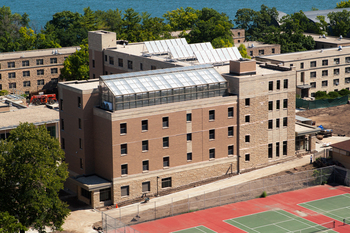UW-Madison’s newest residence hall achieves LEED Gold
Tom Bryan, program coordinator of the Greenhouse Learning Community, checks on the root system of lettuce plants growing in a hydroponic container in the rooftop greenhouse at Aldo Leopold Residence Hall.
When the UW–Madison Division of University Housing began planning Aldo Leopold Residence Hall, the division had a concept of building the most sustainable student housing on campus. Now, that vision has come to life with the announcement that Leopold, which opened in August 2013, has achieved LEED Gold certification for its design and operation.
LEED, or Leadership in Energy & Environmental Design, is a green building certification program that recognizes best-in-class building strategies and practices. Gold certification is the second-highest level possible in their rating system.

In keeping with the example set forth by its namesake, the building was designed and built with renewable materials, energy efficiency, and environmental design in mind.
Photo: Joel Ninmann
In keeping with the example set forth by its namesake, noted conservationist and UW professor Aldo Leopold, the building was designed and built with renewable materials, energy efficiency, and environmental design in mind. The 64,400 square foot structure is home to 176 students, a rooftop greenhouse, and the environment-oriented GreenHouse Learning Community, which offers programs in sustainability, energy efficiency and agriculture.
The residence hall, designed by Eppstein Uhen Architects (EUA), also features other innovative sustainable features and building practices, including:
- Roof-mounted solar panels
- Individual climate controls in each room
- Dual level lighting, daylighting and occupancy sensors
- Energy air exhaust recovery wheel
- Green power (wind)
- Parking for more than 100 bicycles
In addition to these features, the creation of the building was meant to reduce the impact on the environment with eco-conscious building practices, such as:
- 88 percent of construction waste diverted from landfills
- 47 percent locally extracted/manufactured materials
- 31 percent reduction in water runoff
“This is a great accomplishment for all those who contributed to the design and construction of Aldo Leopold Residence Hall,” says Mike Kinderman, director of residence hall facilities for University Housing. “This award and project complement the Greenhouse Learning Community in Leopold and provide for a true living-learning experience with a theme of sustainability.”
—Brendon Dybdahl




